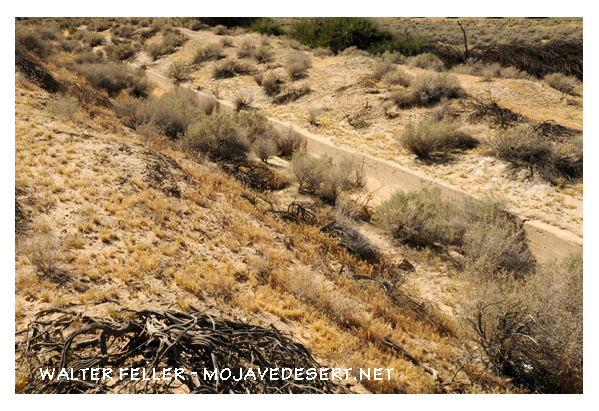Daggett Ditch

Water is essential to life in the desert, and as the population of non-miners grew, locals began thinking of diversifying into agriculture to keep the area alive. In anticipation, they began a program to carry water from the Mojave River toward Daggett through a dam and ditch system. Today the Daggett Ditch, also known as the Minneola Canal, is one of the oldest historic irrigation projects on the Mojave River.
The Mojave River is largely an underground waterway, with water flowing beneath the sand and rarely visible at the Surface; it is sometimes referred to as the “Upside-Down River.” In 1893, a company was formed to try to build a submerged dam that would impound and then divert water into an irrigation ditch. Stock for the new company was issued, on the premise that water would generate electricity to sell to the mines and mills at Calico and pay for the ditch, thereby providing the farmers and citizens of Daggett with a free supply of water. Homesteading claims for over 1,800 acres of land were filed with the federal government in anticipation of the new water system. Even though the dam was built, the project failed, creating less than three percent of what was needed to realize those high hopes.
In 1901, four individuals, including Theodore Strong Van Dyke and his son Dix Van Dyke, formed a new company and started to improve the old dam and line the old Daggett Ditch. Through their efforts, they were able to bring irrigation to 320 acres of new farm land east of Daggett (including the Van Dykes’ ranch) by 1902. This was the first large area to be irrigated in the Mojave Desert. The dam was located in the Mojave River northeast of the Marine Corps Logistics Base today. The earthen ditch delivered water ten miles from the dam and its as-sociated artesian wells to irrigate orchards and alfalfa fields in the six miles between Minneola and Daggett. With the addition of water, the Van Dyke ranch became the first place in California after leaving the Colorado River to find hay and alfalfa for teams of horses and a popular stop for travelers.
from; Of Mines and Mules: A History of Daggett
By Cindy Baker - PAR Environmental Services, Inc.
-
An irrigation ditch that was started in 1902 and ran from the Mojave River 4 miles upstream of the Van Dyke Ranch to Daggett and was used to irrigate crops. It ran along the south side of the river and passed through Daggett before reaching the Van Dyke Ranch. There were fish in it in the 1950s and it was still in use into the 1970s. Also known as Mineola Canal and the Wind and Water ditch.
Mojave Desert Dictionary - P. Schoffstall - Mojave River Valley Museum
Daggett Ditch
The headworks of the Daggett Ditch were begun by the Silver Valley Land and Water Company about 1890. It was then the intention to collect the underflow of the Mojave River and convey it to the Calico mining district north of the river, near Otis (Yermo P. 0.)- After constructing some works at the "Fish Ponds," near Nebo, the promoters were unable to finance the completion of the enterprise and the work was resumed by the Southern California Improvement Company in 1893, who changed the plan to a ditch on the south side of the river for the purpose of irrigating land near Daggett and Minneola. A submerged dam of sheet piling driven down through the sands of the channel and into the subsurface clay was placed across the river and a tunnel or gathering flume was excavated above this dam to receive the water and deliver it to the ditch. The ditch was constructed from the intake to the Daggett ranch, a distance of four miles, and from there to the town site of Minneola, an additional six miles. The company's activities terminated with bankruptcy. In 1901 a copartnership of four persons undertook the improvement and completion of the works. The headworks which had been damaged by flood were improved, 30-inch concrete pipe was laid in the first mile of the ditch and covered with earth, and the remaining three miles of ditch leading to the Daggett ranch was lined with concrete and covered with boards. The ditch from Daggett to Minneola was abandoned.The gathering tunnel at the intake is about one-half mile long and is timbered on top and sides. The ditch is claimed to have a capacity of 1,600 miner's inches. By agreement among the owners the Daggett ranch is entitled to the first 200 miner's inches of water secured and only this amount has been developed. An area of 250 acres on the ranch is all that is irrigated regularly under this system. Surface flood water in the river reaching the intake can be turned into the ditch and occasionally some additional land has been irrigated in this manner. The present owners claim to have spent $75,000 and each of the two companies preceding them is said to have spent a larger amount.
STATE OF CALIFORNIA DEPARTMENT OF ENGINEERING BULLETIN No. 5
REPORT ON THE
Utilization of Mojave River for Irrigation in Victor Valley, California 1918